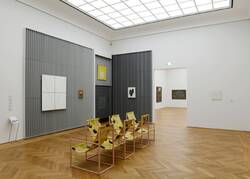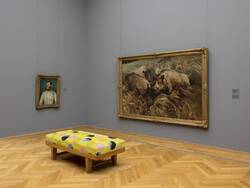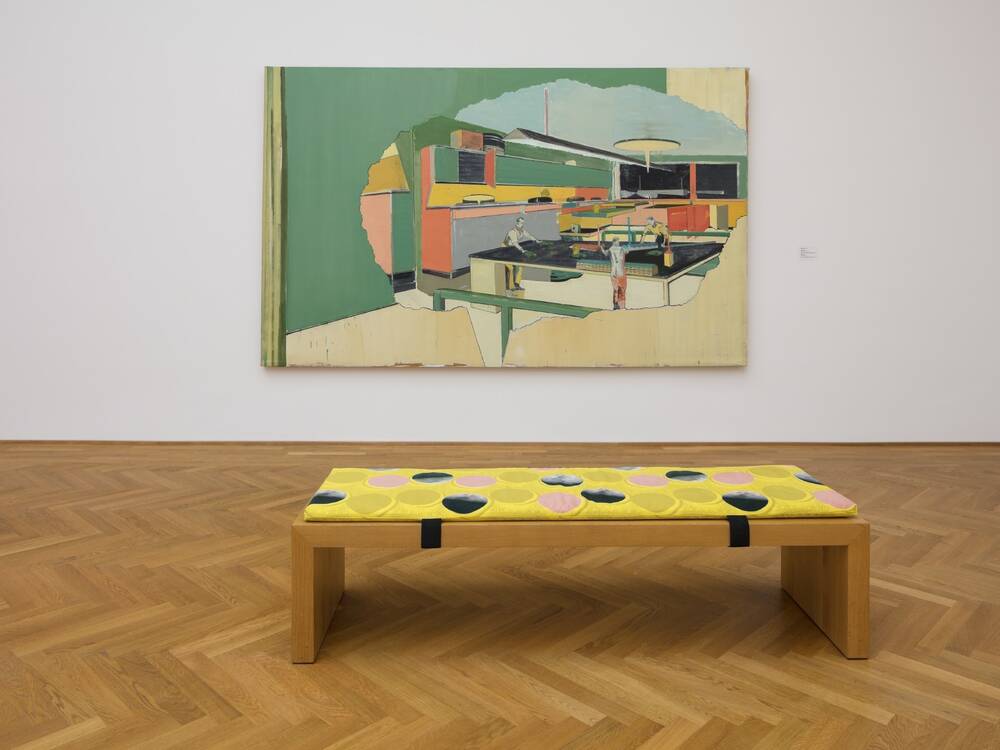Céline Condorelli: Ausstellungsliege and Spatial Composition 12, 2019
Normally, the seating in museums is designed, first and foremost, to blend in and leave the art works to speak for themselves. In the Albertinum, that was just the same – until we invited artist Céline Condorelli, born in Paris in 1974, to create an art intervention here. She conducted research into seating areas in the museum, explored the storage facilities, and asked staff about items removed from the display. Then she transformed six benches from different periods into artworks. Since 2019, these renewed benches have been integral elements of the galleries. She also designed a complementary seventh element herself. Her Spatial Composition 12, a steel tube construction, is a hybrid of sculpture and deck chairs.
You are welcome to sit on any of the benches, view the works on the walls and talk to each other about them. After all, the Albertinum is not a ‘sacred hall for the arts’, but a place of encounters, dialogues and exchanges – something also epitomised by these works by Céline Condorelli.
They are all connected by a single element – the fabric on the upholstery of the benches, deck chairs, or cushions. The design is inspired by African wax prints. The bold serial patterns and colours of these textiles are reminiscent of handmade wax print fabrics – though today, they are manufactured industrially. Wax print fabrics are often associated with Africa, although it was only through the colonial networks that they passed into domestic production there. Céline Condorelli’s light pink tone in her fabric references the colours of walls in historic exhibition spaces. The moon, depicted in different forms, not only represents a universal cycle of time, but also alludes to Caspar David Friedrich’s Two Men Contemplating the Moon, one of the Albertinum’s main works. Here, then, Condorelli forges another arc across times and cultures – also as a way of showing how an exhibition space can never be neutral, but is always influenced by historical resonances and present conditions.
Further Media
Céline Condorelli has long been investigating the phenomenon of the exhibition. She is especially interested in the audience in exhibitions, and has noticed how visitors behave in a very particular way.
„Die Menschen sind sehr gut geschult. Wenn sie ein Museum betreten, wissen sie, was sie anfassen dürfen und was nicht. Das ist das Kunstwerk und das ist das Licht. Das ist die Bank und das ist das Belüftungssystem. Jeder weiß, dass es diese Flyer gibt, die man mitnehmen kann, und Dinge, die aus demselben Material bestehen, nämlich aus Papier, die man nicht mitnehmen und nicht anfassen darf.“
For example, the sketches which, as art works, are hanging on the walls. This led Céline Condorelli to consider the hierarchy of things in a museum:
„Diese Hierarchie der Arbeit ist es, die mich letztendlich interessiert. Warum bewerten wir bestimmte Arbeiten höher als andere? Worin genau besteht die Arbeit, wenn man Kunst macht? Es ist nicht nur die Malerei. Es ist natürlich alles drum herum, das total wichtig ist. Die Präsentation, dass ein Text an der Wand dazugeschrieben wird, die gesamte Finanzierung dahinter, das System, das künstlerische Arbeiten fördert oder nicht fördert. Als Künstlerin konzentriere ich mich auf wenige Dinge. Wenn man sich zum Beispiel auf eine Museumsbank setzt, merkt man vielleicht gar nicht, dass das ein Kunstwerk ist. Aber das wirft Fragen auf; sehr einfache Fragen, die ich aber für sehr sinnvoll halte. Welchen Status hat das Ding, auf dem ich sitze, im Vergleich zu dem Ding, das ich betrachte?“
As a rule, according to Céline Condorelli, culture is presented in exhibitions as something needing to be protected from people. But her benches are both an art work – and an everyday object.
„Manchmal geht man in eine Galerie und denkt, dass man schmutzig ist oder laut, oder man weiß, dass der eigene Körper dieses Extra ist, das stört, weil man etwas tun könnte, das stört. Diese Vorstellung, dass die Ausstellung ohne dich besser ist, ist sehr stark, aber auf einer grundlegenden politischen Ebene völlig falsch, absolut falsch. Die Kunstwerke existieren nicht ohne Menschen und ohne ein Publikum.
Es ist doch ziemlich seltsam, zu denken, dass Kultur von einem ferngehalten werden sollte, unantastbar sein sollte, nicht Teil des täglichen Lebens sein sollte. Ich sage nicht, dass alles für jeden zugänglich sein muss. Mich interessiert einfach die Vorstellung einer intimeren Kultur; und ob es möglich ist, kulturelle Arbeiten, künstlerische Arbeiten in den Alltag zu integrieren."
- Location & Dating
- 2019
- Material & Technique
- existing seatings, printed canvas fabric, padding, velcro
- Museum
- Galerie Neue Meister
- Inventory number
- Inv.-Nr. 2019/03




